Women in World War I: Pioneering Military & Civilian Roles in the Great War
📌 Discover the remarkable contributions of women in World War I, from military service and Red Cross nursing to intelligence and communication roles. Learn how women’s participation in the Great War shaped future generations.
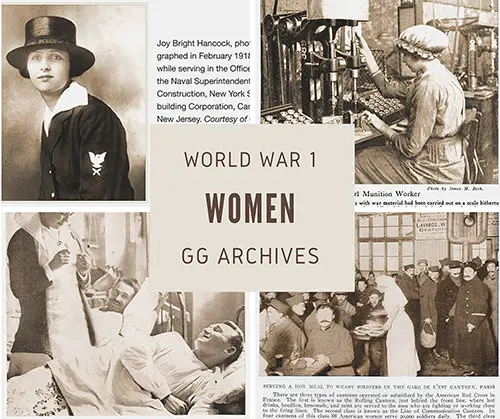
📜 Women in the Great War - World War I
🔍 A Transformative Role for Women in WWI
The Women in the Great War - World War I section provides an in-depth exploration of how women contributed to the war effort, both at home and overseas. It highlights the groundbreaking shift in gender roles as women moved into military, medical, and administrative roles, many of which were traditionally held by men.
This page is a must-read for teachers, students, historians, genealogists, and military researchers, as it documents the pivotal moments that shaped women's involvement in World War I and their lasting impact on military and civilian sectors.
For the first time in history, American women were formally recruited into the U.S. military, marking the beginning of their long journey toward equality in the armed forces. Their contributions ranged from serving as nurses, telephone operators, and clerks to working in intelligence, munitions assembly, and recruitment.
World War I was the first war in which American women were recruited to serve in the military. Women were already present in France as members of the American Red Cross. As canteen workers, but for the most part, French and Belgian women staffed American military offices.
In October 1917, the new American Expeditionary Forces (AEF) telephone system was implemented. Still, the American soldiers and the French women working as telephone operators could not communicate. The need for bilingual telephone operators precipitated the recruitment of American women.
Captured Army and Navy Nurses to be Supported by Red Cross - 1918
If the Germans capture any Army or Navy nurses, the American Red Cross will support them during captivity. This decision follows closely upon the announcement that, under the law, the pay of Army nurses.
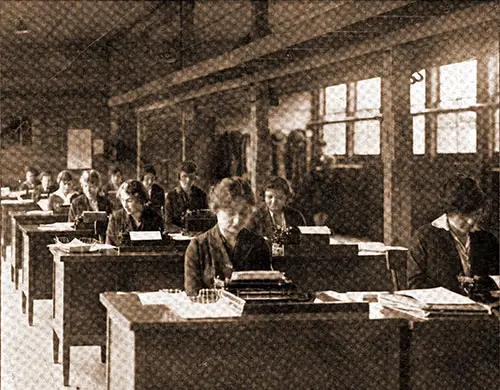
Girl Patriots At Great Lakes - 1919
Over in one of the largest regiments at Great Lakes, the fifteenth is located the workshop for twelve intrepid young ladies. Intrepid because they all left good homes and came “west” because America needed them.
Homes Wanted For American Women in France - 1918
The demand in France for the YWCA and its warm, efficient hospitality grew entirely out of bounds in the days before peace was declared. By cable came a series of desperate pleas.
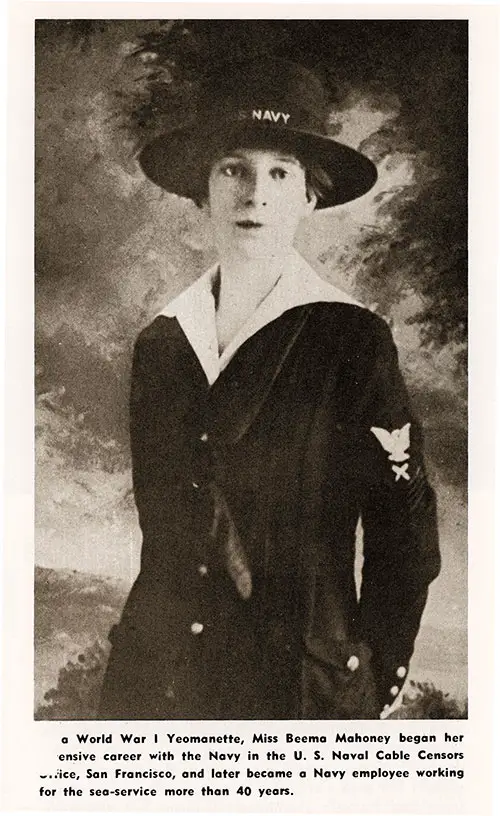
Navy Women of World War One - 1972
The Establishment of Yeoman (f), better known as the Yeomanette, was accomplished under the provisions of an Act of 29 Aug 1916, which set up the Naval Reserve Force.
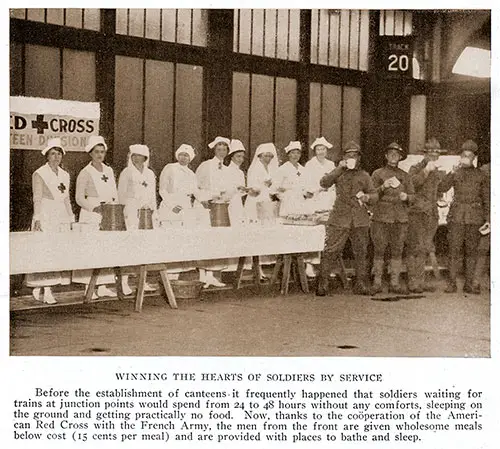
The Symbol of Service to Mankind – The American Red Cross - 1918
Hence, canteens and rest stations, and all their cooperation with the government, YMCA, and other war agencies, render the soldier life as tolerable, comforting, and heartening as possible.
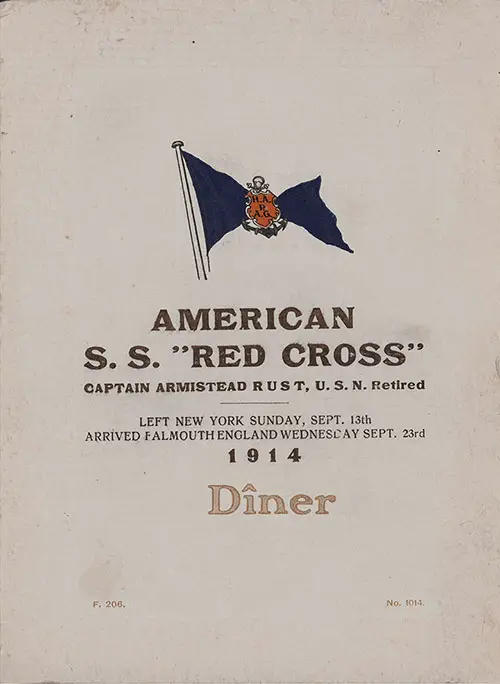
Emergency detachments of the Nursing Service have been found necessary because of war. The body of enrolled Red Cross nurses constitutes the Army and Navy Nurse Corps reserve.
The Red Cross Organization During The War - 1918
Woman's Bureau of the Red Cross—Its purposes and plans—A general survey—Supply service and Bureau of Standards—Knitting, hospital garments, surgical dressings, comfort kits, etc.—Home service—Volunteer aids—Work organized, and canteens established in France—Junior Red Cross—School fund—Red Cross school activities—How to organize.
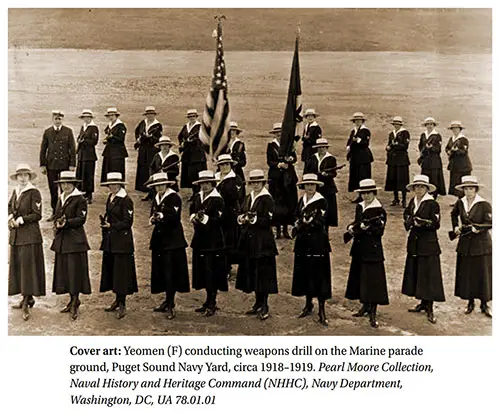
USN First Enlisted Women: Introduction
I am honored to contribute The Navy’s First Enlisted Women: Patriotic Pioneers to the Naval History and Heritage Command’s (NHHC) commemoration publications for World War I.
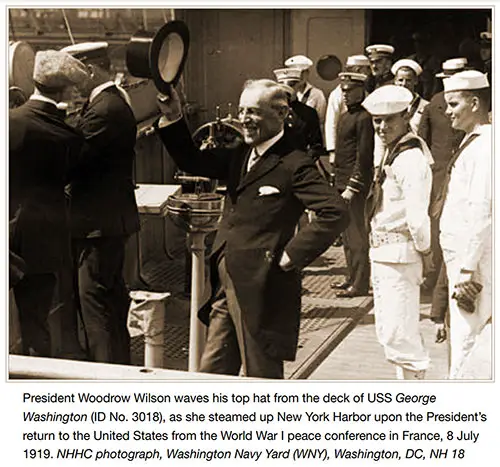
USN First Enlisted Women: Setting the Stage - 2019
This chapter provides essential context for the history of the Navy’s first enlisted women. It highlights sharp contrasts our founding principles, democratic values, justification for war, and the treatment of women and African Americans.
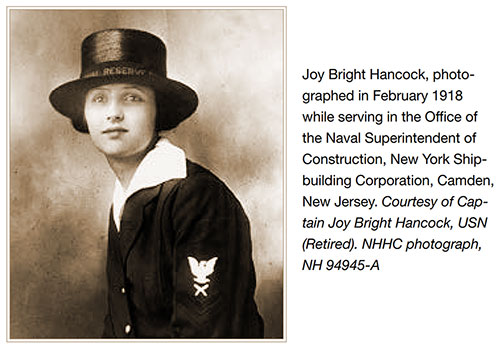
USN First Enlisted Women: “Women Join the Navy”
Over 11,000 women from every state, American territory, and the District of Columbia volunteered to enlist into the United States Navy to free male Sailors for combat duties.
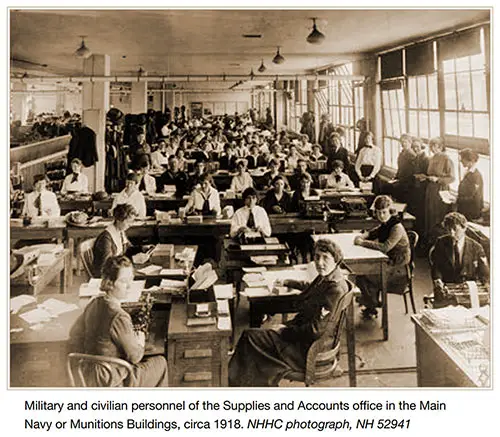
USN First Enlisted Women: “Reporting to Work”
The Navy’s first enlisted women worked at naval commands across the United States and overseas, supported Allied operations and campaigns, and contributed directly to the Allied victory.
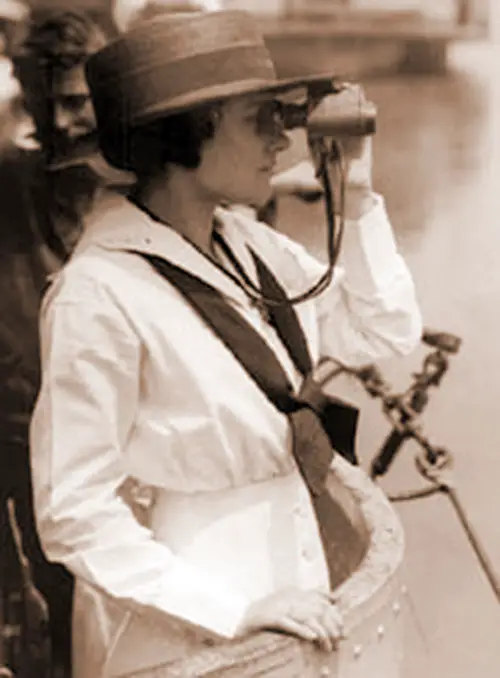
USN First Enlisted Women: “Changing the World, Their Lives, and the Navy”
Despite their invaluable service, yeomen (F.) had to fight for the rights and benefits they deserved. Post-war developments mirrored pre-war beliefs about military women and a lack of respect for them.
USN First Enlisted Women: Conclusion
Though enlisted primarily to provide clerical support, they excelled in munitions assembly, intelligence, cable decoding, recruitment, and other non-administrative specialties.
USN First Enlisted Women: Epilogue
The yeomen (F.) enhanced the legacy of the women who had previously supported the nation during wars, conflicts, and crises, and set an example for those who followed them.
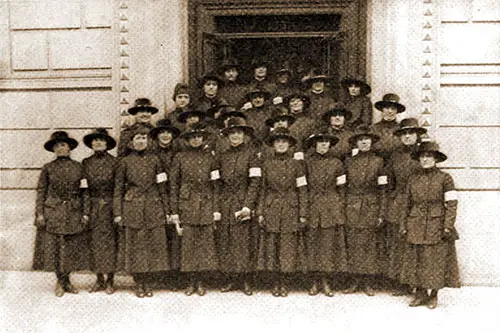
US Signal Corps Unit At Headquarters - 1918
The third telephone unit of the signal corps of the United States Army is ready to start for “Some place in France.”
War Work of the Hostess House Committee - 1919
The total number of hostess houses for which the committee assumed responsibility for November 1, 1919, is 124. Of these, 17 have been for [African-American] visitors.
War Work of Young Women's Christian Association - 1918
From the beginning, the War Work Council planned to include not only American women affected by the war, but because of the pleas from France and Russia, the first budget contained an item for work in Europe.
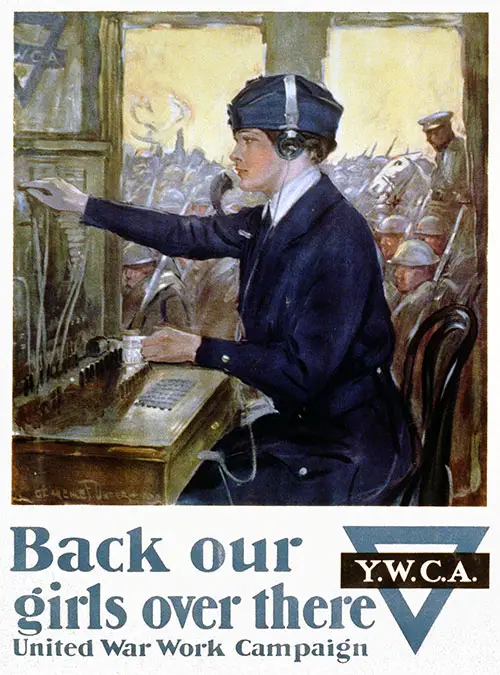
What Peace Means To The YWCA - 1918
We have whole nations to feed, entire peoples to clothe, and the most stupendous task of economic reconstruction the world has ever seen.
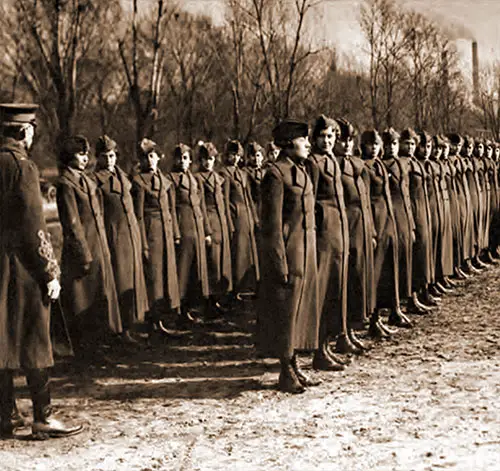
Women Marines in World War I - 1974
When it was discovered that there was a sizable number of battle-ready Marines still doing clerical work in the United States who were urgently needed overseas, the Corps turned in desperation to the female business world.
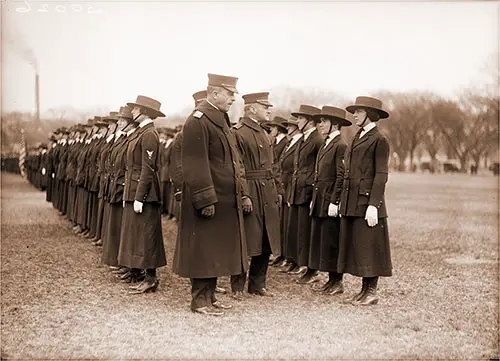
The Yeomen (F) of WWI: Women in the U.S. Navy’s Pioneering Roles
The article A Yeomenette Story from the Great War (2006) provides a detailed and enlightening account of the pivotal role women played in the U.S. Navy during World War I, specifically focusing on the Yeomen (F) — the female members of the Naval Coast Defense Reserve.
For historians, genealogists, educators, and students studying military history and gender roles in the military, this article serves as a valuable resource in understanding the evolution of women’s contributions to the armed forces, particularly in the early 20th century.
It sheds light on how women were able to serve in a time when the military was predominantly male and provides insight into the challenges and discrimination they faced, as well as their achievements and lasting impact on the U.S. Navy.
🌟 Most Engaging & Noteworthy Aspects of This History
📌 Women in Military Service: A Historic First (1917-1919)
📌 The First Women in the U.S. Military
🔹 Before WWI, women had never been officially enlisted in the U.S. military.
🔹 The war created an urgent need for bilingual telephone operators, clerks, and office workers.
🔹 In 1917, the U.S. Navy established the Yeoman (F), or “Yeomanettes”, allowing women to serve officially.
🔹 By the war’s end, over 11,000 women had enlisted in the Navy, freeing male sailors for combat.
🔹 The U.S. Marine Corps and Army followed suit, recruiting women for clerical and logistical roles.
📌 Notable Individuals: Pioneers of Military Service
✔ Joy Bright Hancock – A pioneering Yeoman (F) who later became one of the first women to serve as a Naval officer.
✔ Beema Mahoney – Served as a Navy Yeomanette, later working over 40 years in the U.S. Navy.
📝 Why This Matters:
✔ Highlights the groundbreaking moment when women entered military service.
✔ Illustrates how WWI set the stage for future military inclusion of women.
✔ Provides historical context for today’s female service members.
📌 Women in the Red Cross: A Lifeline for Soldiers
📌 Red Cross Nurses & Emergency Medical Teams
🔹 Red Cross nurses played a critical role in battlefield medicine.
🔹 The American Red Cross expanded globally, with nurses stationed in France, Belgium, and beyond.
🔹 Emergency detachments formed the Army & Navy Nurse Corps Reserve, ensuring continued medical care.
🔹 Captured nurses were supported by the Red Cross, demonstrating their commitment to humanitarian aid.
📌 Canteens & Rest Stations: Comforting Soldiers Abroad
🔹 Women operated canteens, rest stations, and field hospitals, ensuring troops had food, medical aid, and morale-boosting support.
🔹 The Symbol of Service to Mankind – The American Red Cross became an icon of care and dedication.
📝 Why This Matters:
✔ Showcases women’s role in wartime medical care and humanitarian aid.
✔ Emphasizes the Red Cross as a crucial wartime organization.
✔ Offers genealogists insight into family members who served as nurses or Red Cross volunteers.
📌 The Women’s Army Signal Corps: Breaking Communication Barriers
📌 The Need for Bilingual Telephone Operators
🔹 French and American soldiers struggled to communicate, leading to the recruitment of bilingual American women.
🔹 The U.S. Army Signal Corps formed specialized telephone units, ensuring efficient battlefield communication.
📌 US Signal Corps: Women on the Front Lines of Communication
🔹 The third telephone unit of the Signal Corps was ready for deployment to France in 1918.
🔹 These women operators played a crucial role in relaying messages between Allied forces.
📝 Why This Matters:
✔ Demonstrates the strategic importance of communication in warfare.
✔ Highlights the overlooked contributions of women in intelligence and logistics.
✔ Relevant for researchers studying wartime technology and innovation.
📌 Women’s Contributions in the Navy & Marine Corps
📌 The Yeomanettes: First Women in the Navy
🔹 Women enlisted as Yeoman (F) clerks, working in administration, intelligence, and munitions assembly.
🔹 The establishment of Yeoman (F) in 1916 paved the way for women’s military integration.
🔹 Drills & weapons training were part of their duties, preparing them for a range of roles.
📌 The Role of Women in the U.S. Marine Corps
🔹 The Marine Corps recruited women to fill clerical positions so that battle-ready Marines could deploy overseas.
🔹 The first enlisted women in the Marine Corps performed administrative duties, but their presence was revolutionary.
📌 Overcoming Discrimination & Earning Respect
🔹 Despite their service, Yeomanettes and female Marines struggled for recognition.
🔹 Many were denied benefits post-war, and their contributions were overlooked for decades.
📝 Why This Matters:
✔ Highlights the pioneering role of women in military service.
✔ Demonstrates the early struggles of female service members for equality.
✔ Relevant for military historians studying gender roles in the armed forces.
📌 Women’s Civilian Efforts: The YWCA & Hostess Houses
📌 YWCA & War Work of the Hostess House Committee
🔹 The Young Women’s Christian Association (YWCA) provided housing, meals, and services to women working for the war effort.
🔹 Hostess Houses were established for African-American visitors, reflecting the challenges of race and segregation in WWI America.
🔹 The YWCA also provided aid to French and Russian women affected by the war.
📌 Back Our Girls Over There: Supporting Women in Wartime
🔹 A United War Work Campaign poster urged Americans to support women volunteers overseas.
🔹 Women worked in war factories, offices, and hospitals, contributing to wartime production and administration.
📝 Why This Matters:
✔ Highlights the civilian support efforts behind the war.
✔ Demonstrates the intersection of gender and race in wartime roles.
✔ Essential for understanding the home front experience in WWI.
📷 Noteworthy Images & Their Significance
📷 "Yankee Pluck" – Twelve Women at Great Lakes Naval Station (1919)
🔹 Showcases the courage and patriotism of women who left their homes to serve.
📷 "Winning the Hearts of Soldiers by Service" – American Red Cross in Action
🔹 Symbolizes women’s selfless dedication to soldiers’ well-being.
📷 "Yeomanettes Conducting Weapons Drills" – Female Navy Personnel in Training
🔹 A powerful image demonstrating women’s increasing military presence and capability.
📷 "US Signal Corps Unit at Headquarters (1918)" – Women Telephone Operators
🔹 Highlights the pivotal role of women in wartime communication and intelligence.
📚 Relevance for Different Audiences
📌 🧑🏫 For Teachers & Students:
✔ Provides a comprehensive look at women's roles in WWI.
✔ Encourages discussions on gender, war, and social change.
📌 📖 For Historians & Military Researchers:
✔ Explores the contributions of women in military, medical, and civilian roles.
✔ Examines the lasting impact of women’s WWI service on future generations.
📌 🧬 For Genealogists & Family Historians:
✔ Helps trace female ancestors who served as nurses, Yeomanettes, or Red Cross volunteers.
✔ Offers a valuable list of roles and organizations for research.
🌟 Final Thoughts: A Defining Moment for Women in Wartime
📌 World War I was a turning point for women’s roles in military and civilian service.
✔ Their contributions in nursing, clerical work, and combat support were invaluable.
✔ They paved the way for greater inclusion of women in the military.
✔ Their legacy continues to inspire future generations of female service members. 🇺🇸🌍
